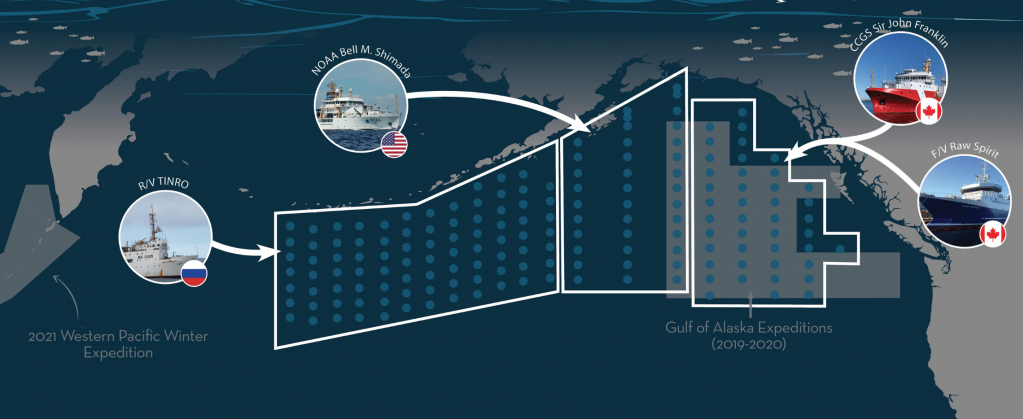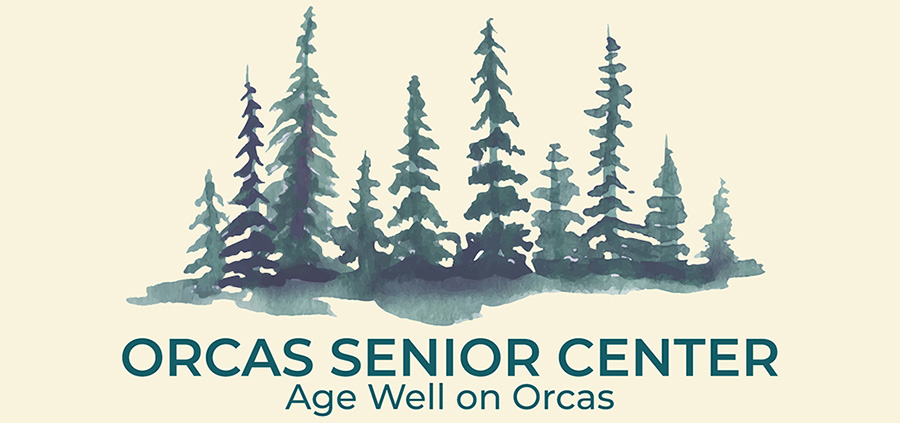||| FROM INTERNATIONAL YEAR OF THE SALMON |||
The International Year of the Salmon (IYS) and the North Pacific Anadromous Fish Commission (NPAFC) are excited to announce the launch of the 2022 IYS Pan-Pacific Winter High Seas Expedition supported by NPAFC member countries (Canada, Japan, the Republic of Korea, the Russian Federation, and the United States of America) and partners. Four research vessels and over sixty scientists and crew will depart their respective ports between late January and mid-February 2022 to conduct the largest ever pan-Pacific research expedition to study salmon and their ecosystems in the North Pacific Ocean.
The 2022 Expedition is a major international effort engaging governments, academia, NGOs, and industry to begin a new collaborative approach to filling the gaps in our understanding of what is happening to salmon in a rapidly changing North Pacific Ocean. Four research vessels will be deployed between January and April 2022 to cover four zones spanning the North Pacific. The fleet for the 2022 Expedition will include one research vessel from Canada (the CCGS Sir John Franklin), one from the United States (the NOAA Ship Bell M. Shimada), one from Russia (the R/V TINRO), and a commercial fishing vessel from Canada (the F/V Raw Spirit).
While the vessels are at sea you can follow their progress on the IYS Website and on all IYS online media platforms (Twitter, Instagram, Facebook). There will be a series of activities for the launch and return of individual vessels.
Building off successful international expeditions into the Gulf of Alaska in 2019 and 2020, and the 2021 Western Pacific Winter Expedition, the major objective of the 2022 Expedition is to better understand how increasingly extreme climate variability in the North Pacific Ocean and the associated changes in the physical environment influence the abundance, distribution, migration, and growth of Pacific salmon. To document salmon ecology, vessels will systematically deploy oceanographic gears and trawl nets at stations approximately 60 nautical miles apart across the North Pacific Ocean, sampling environment and ecosystem from microscopic plankton to large predators such as salmon sharks, with an emphasis on catching salmon and associated species. The Canadian commercial vessel will simultaneously deploy gillnets to assess the effectiveness of trawl nets to sample the community of fishes and composition of salmon, including steelhead, in these surface waters. All of the data collected will be made publicly accessible.

Novel technologies such as genomics, environmental DNA (eDNA), and ocean gliders will be utilized to test their potential to enhance our monitoring of salmon and the ecosystem. Recent advancements in DNA analyses allow researchers to determine the river of origin for salmon caught during the expedition, which enables us to understand for the first time how different stocks of salmon are distributed across the North Pacific. eDNA analyses will allow researchers to assess the full range of the biodiversity, especially for species not captured in traditional sampling gears.
The 2022 Pan-Pacific Winter High Seas Expedition is made possible by in-kind ship time contributions from Canada and the United States, and additional financial and technical contributions from Fisheries and Oceans Canada, the British Columbia Salmon Restoration and Innovation Fund (Fisheries and Oceans Canada and the Province of British Columbia), the National Oceanic and Atmospheric Administration, the North Pacific Research Board, the Great Pacific Foundation, the Pacific Salmon Foundation, the Russian Federal Research Institute of Fisheries and Oceanography, Japan Fisheries Research and Education Agency, the North Pacific Anadromous Fish Commission, the North Pacific Fisheries Commission, the Alaska Department of Fish and Game, the Washington Department of Fish and Wildlife, the Tula Foundation, the University of Alaska Fairbanks, the University of British Columbia, Oregon State University, and the University of Washington.
About International Year of the Salmon
The IYS is a five-year initiative (2018–2022) to establish conditions for the resilience of salmon and people in a changing world. It is a hemispheric partnership led by the North Pacific Anadromous Fish Commission in the North Pacific, the North Atlantic Salmon Conservation Organization in the North Atlantic, as well as by NGOs, the private sector, governments, and academic organizations.
About NPAFC
The NPAFC is an international organization that promotes the conservation of salmon (chum, coho, pink, sockeye, Chinook, and cherry salmon) and steelhead trout in the North Pacific and its adjacent seas and serves as a venue for cooperation in and coordination of scientific research and enforcement activities. The NPAFC Convention Area is located in international waters north of 33°N latitude in the North Pacific, Bering Sea and the Sea of Okhotsk beyond the 200-mile zones of coastal States. NPAFC member countries include Canada, Japan, the Republic of Korea, the Russian Federation, and the United States of America.
Information and Updates for the 2022 IYS Pan-Pacific Winter High Seas Expedition:
2022 Expedition Webpage:
https://yearofthesalmon.org/2022expedition/









A pressing need. Good news and Godspeed–Thank you!
Afterthought–It occurs to me that, since these are anadromous fish, we can play an important complementary part by protecting and enhancing our coastal streams and salmon spawning habitat, and doing land-side surveys: Environmental Department, Marine Resources Committee, Moran State Park, Glenwood Springs Hatchery, Land Bank / Coho Preserve, Jenny deGroot.